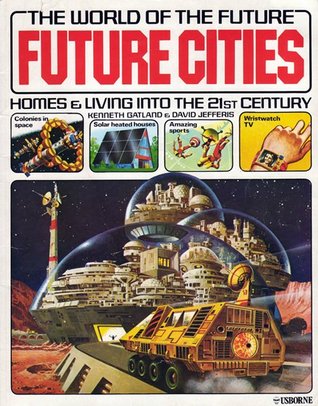
Here are two things I know to be true: we live in a ridiculously futuristic time, and it just kinda fucking sucks. We are hurtling towards the technological singularity at an alarming rate and mostly what we have to show for it is messaging apps with real-time face-swaps and food delivery services that massively underpay their workers by using weird loopholes to subvert hard-earned industrial relations laws. The idea of being disappointed in our progress is an absurd one, though. How could we possibly predict how the future is going to go if we’ve never been there before? But the metrics I’ve used to arrive at disappointment didn’t come from nothing, they came from one very specific place: 1979’s The Usborne Book of the Future by Kenneth Gatland and David Jefferis.

Pictured: Basically cocaine for socially awkward short-sighted pre-teens. (Image: Usborne Books)
This iconic work, along with a lot of Asterix and a chunk of books about medieval arms and armour, occupied most of the lunches that I spent in the library during primary school. From where I was sitting in the non-fiction section of the Kambora Public School library in 1998, the future looked incredible, and not even that far away. But we’re here now, almost a fifth of the way into the 21st century, and I think we can all agree that it’s just a little bit shit. A more accurate version of the book would have just documented TVs getting bigger and phones getting smaller as wealth was further concentrated into the hands of fewer and fewer billionaires, while the planet tries its best to violently shake us from it because large corporations have irrevocably destroyed it in the pursuit of maximising profits to shareholders at the expense of human lives. But I imagine that would not have made great reading for children.
To be fair, not all of the predictions made in The Book of the Future were completely wrong. While most of the book is wildly optimistic, some of it massively underpredicted the advances we would make, mostly as it relates to things like the internet and emails, though, instead of things like, say, building giant cities on the moon. Apropos of nothing at all, we thought we’d see how the books stack up.
Robots
Most science fiction from the last hundred years has always been optimistic that robots were going to play a huge part in the near future – the age of humanoid robots carrying around trays of drinks and vacuuming our homes always seemed just around the corner. Instead, we got Roombas and Siri. We use machine learning for a lot of things (how Google Translate works is a great example of this), but we’re far off from even the relatively modest predictions in 1979’s Alien and 1982’s The Thing that soon computers would be able to deal well with natural language questions.
The Book of the Future predicted that between the years 1991 and 2000 the “reign of the robot” would draw near, as we steadily improved robot “vision, movement, manipulation, and ‘thinking’“. A bunch of which we’ve only really gotten good at in the last decade – but it turns out getting something to move like a human on two legs is insanely fucking hard, and we’re only just figuring it out now. Their prediction that robots would “increasingly take over the jobs of skilled engineers in factories“, however, was pretty well spot on.
If we’re to believe that the year shown on this chill dude’s computer is the current year, the prediction that in 1989 we would have these incredibly stylish drink-toting cocktail robots (number 5) did not come to pass, much to my disappointment.

Pictured: Hot looks of the futuristic late 80s. (Image: Usborne Books)
Between 2001 and 2050, the book predicts that we will have micro-processing mini-robots in our brain, construction robots in orbit, robots landing on asteroids, and mining robots on the moon, but I guess we’ve still got another 32 years for that one to come true.
Phones
The book is relatively accurate in its predictions about mobile communication, except it didn’t anticipate one thing: that smartwatches look like shit. Not realising how incredibly dorky they would turn out to be, The Book of the Future imagines that all of the sorts of technology now localised to our mobile phones would be in incredibly bulky wristwatches, which they have hilariously named ‘ristos’.

Pictured: God I wish they had called this the ‘wristy’. (Image: Usborne Books)
Like most science fiction from the time (and also now), the book is quite keen on the idea that we’ll have video built into home phones, but this didn’t happen largely because a) no one uses home phones and b) no one is always ready to be visible to another person.
Homes
Houses aren’t all that much different than they were 40 years ago, except now there’s a thing plugged into the wall capable of broadcasting the sum of human knowledge to like 7 devices spread throughout at my house and there’s a speaker in my bathroom that I can yell at from the bathtub and it will play Dopethrone for me. So pretty different, I guess.
The Book of the Future‘s predictions manage to both fall short of the mark and wildly overshoot, predicting that near future home video technology will be done on small spools of magnetic tape, and that that technology will, in turn, be swiftly eclipsed by “3-D holographic” video. Imagine how disappointed they’d be if you showed them what a 2018 ‘3D’ TV was.
As depicted in the image with the tracksuit guy, the book is right about the huge size of modern TVs, and even right about the fact that we will move to flat screens, imagining a TV with “a thickness of less than five centimetres“. It also quite nearly nails the concept of internet shopping, speculating about a TV “used to order shopping via a computerised shopping centre a few kilometres away“.
The book is also surprisingly spot-on about urban farming and the upswing in bicycle usage, anticipating that would be an increased need for both. The prediction that between 1980 and 1990, we would see the first domestic ‘slave’ robots to help around the house sadly did not come to fruition – all we’ve got is a disc-shaped autonomous vacuum that can’t get into corners.
Cars
Maybe because it’s common sense to make them more aerodynamic and to add blind-spot cameras, but the book absolutely nails it when it comes to trucks – although they were maybe 30 years too optimistic. This diagram of a possible 1980s truck bears a striking resemblance to Uber‘s Semi. They can’t take credit for inventing ABS (first showcased in 1978), but they were right in predicting its proliferation.

Pictured: Imagine a future without window tinting. Incredible. (Image: Usborne Books)
They were also correct about hybrid cars, fully aware that we would be too chickenshit to go full electric anytime soon:
 Pictured: A boot full of batteries, which they did not think would shrink. (Image: Usborne Books)
Pictured: A boot full of batteries, which they did not think would shrink. (Image: Usborne Books)
The sea
I think we can all agree that the sea is cool as hell, even though we’ve done our best to fill it with plastic. Kenneth and David seemed to be of the mind that we would be using the ocean for much more than we currently are, envisioning a future much less land-based than our present.
The image that stuck with me the most from these books was giant pyramidal floating cities of the year 2000. As we are all aware, this did not come to pass:

Pictured: Imagine if this was real. Imagine it. (Image: Usborne Books)
The closest Australia ever came to this is probably that massive floating hotel that was moored off a reef near Townsville in the late 80s, that shit was incredible.
The book predicted that not only would the first “Sea City” be built before the year 2000, but that it would also be joined by the first underwater city, built in the shallow waters of the Mediterranean Sea.
The Moon
The book hedges its bets somewhat by saying that it’s unlikely that we’ll have a permanent base on the moon “much before 2000“, but is substantially more confident in speculating about a possible Olympics on the moon in the distant, distant future of the year 2020. Unfortunately for us, Tokyo beat the moon in that bid.

Pictured: Bubble torch. (Image: Usborne Books)
Adorably, they imagine that the resident of these ‘Moon Cities’ might call themselves ‘Moonies’, which rules.
In conclusion: I reckon things didn’t turn out quite as dope as I think they could have.



